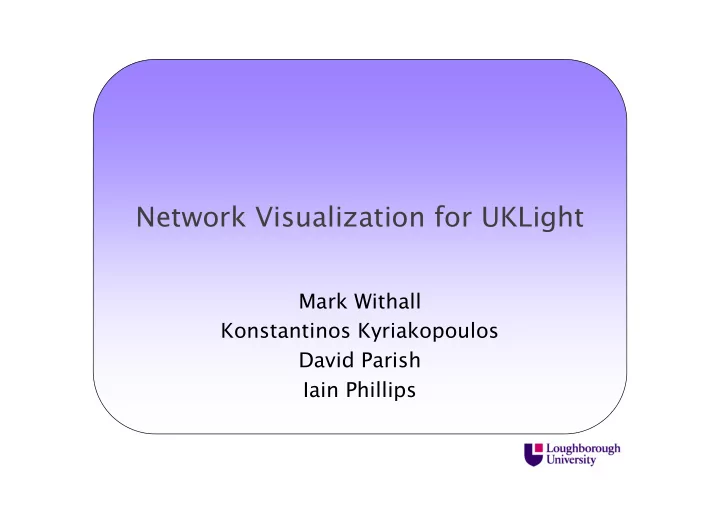

Network Visualization for UKLight Mark Withall Konstantinos Kyriakopoulos David Parish Iain Phillips
Contents • Why use visualisation for networks? • Guidelines • Previous Work • Motivation and Issues for visualisation • Summary
Link Utilisation Data 1120053077 1135 5750 1120053078 786 4550 1120053079 446 2960 1120053080 598 4960 1120053081 398 2960 1120053082 701 5510 1120053083 1054 3790 1120053084 476 2960 1120053085 726 2960 1120053086 602 2960 1120053087 678 2960 1120053088 4156 20610 1120053089 813 2960 1120053090 624 2960 1120053091 1183 5610 1120053092 841 5130 1120053093 841 7390 1120053094 937 7390 1120053095 1178 10760 1120053096 624 5220 1120053097 3903 31830
Link Utilization Data
Why use visualisation for networks? • Computers are great a processing vast amounts of data and presenting it in a visual form • Humans have great visual capabilities • Visual data maps are a powerful tool for presenting large amounts of information • Allow humans to do intuitive and creative aspects of networking • Speed up interpretation of data • Visualization is task and viewer dependent
Visualization Guidelines • Visual Information-seeking Mantra – “Overview first, zoom and filter, then details-on- demand” • Shneiderman’s (1996) seven abstract user tasks – Overview – Zoom – Filter – Details-on-demand – Relate – History – Extract
Visualization Guidelines • Carr’s (1999) guidelines for visualization design – Visualization is not always the best solution – User tasks must be supported – The graphic method should depend on the data – Three dimensions are not necessarily better than two – Navigation and zooming do not replace filtering – Multiple views should be coordinated – Test your designs with users
Types of Visualization • Three main type of network visualization – Geographic • Information presented in geographical context – Abstract Topology • More focus on relationships between nodes – Plot-based • Data about individual points in the network
Geographic Visualization • Information presented in geographical context • Each node located in its ‘real’ location • Data represented by: – Glyph at location (n degrees of freedom) – Edges between locations (colour, width) – Histogram at location
SeeNet - Becker et al (1993)
SeeNet3D - Cox et al (1996)
SeeNet3D - Cox et al (1996)
Swift - Koutsofios et al (1999)
UKLight
UKLight
Abstract Topology Visualization • More focus on relationships between nodes, independent of physical location • Layout becomes a major issue • Glyphs representing locations • Colour and width varying on links between nodes
SeeNet3D - Cox et al (1996)
Zschech et al (2000)
Zschech et al (2000)
UKLight
Plot-based Visualization • Data about individual points in the network • Plots over time ( e.g. delay, loss) • Histograms, pie charts ( e.g. port, protocol) • Icon plots (FDVs - Figural Deformity Visualization)
CoMo Counter gDesklet
FDV
FDV 2
TMT
Motivation • Provide a view of UKLight data • Don’t know who the users are going to be • Don’t know what they will want to do • Need a dynamic, user-driven visual interface • Workflow – Defines the users roles and their needs form the visualisation
Intel CoMo System • CoMo = Continuous Monitoring • General purpose passive network monitor, currently in development • Provides basic functionality with a programmer interface • Users write modules to perform tasks • Four main processes: Capture, Export, Storage and Query • Currently data access in text form via HTTP
CoMo - Data flow view
Practical Issues • Three levels • Data transformation – Transforming monitoring data into a convenient intermediate form • Visualization – Present the data visually • User Interface – User interaction with the visualizations
Framework Raw Monitoring Data Data Transformation Geographic Topology Plot-based Graphical User Interface
Summary • Guidelines for visualization development • Types of visualization – Geographic – Abstract Topology – Plot-based • Preliminary examples from MASTS • Visualisations plans – CoMo
Recommend
More recommend